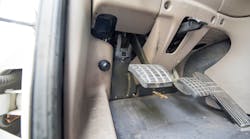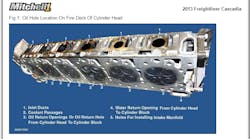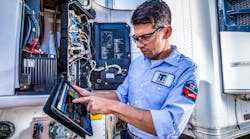As vehicles on the road today become increasingly more reliant on computers and data, diagnostic tools have evolved as part of the frequently used tools for shop technicians.
Questions from professional technicians, fleet managers, and consumers often come up about the difference between the vast array of different automotive and heavy duty scan tools available on the market. A quick review of the general differences between basic versus advanced diagnostic systems may help clear up some of the confusion.
Differences in source
Original equipment manufacturer (OEM) diagnostic scan tools are becoming increasingly available to shops and individuals through time-based licensing directly from manufacturers. These tools typically require a J2534- or RP1210-compatible interface and run on a Windows PC.
In general, these tools have the best support for a given manufacturer’s vehicles. However, OEM scan tools are not as flexible as aftermarket tools and usually cost quite a bit more. This cost can add up, especially when a fleet needs to have one license for each make serviced in the shop.
Aftermarket diagnostic scan tools are created from data licensed through each OEM, combined with extensive test and validation work done by the tool manufacturer. This article will focus on aftermarket diagnostic scan tools.
Differences in capabilities
Aftermarket scan tools fall under two different categories: basic and advanced. Basic diagnostic scan tools or systems, sometimes referred to as generic scan tools, typically can only read data from the engine control unit (ECU), and possibly the transmission control unit (TCU) or hybrid controller. Basic diagnostic tools provide emissions-related data only. In reference to the ECU, TCU, or hybrid controller, the controller in this case essentially means computer. These controllers will run and manage the operation of different systems on a vehicle. The number of controllers varies by car model, but there are generally 20-50 different controllers on a new car, and 10-30 controllers on a new heavy truck.
Most basic scan tools or systems only decode SAE-standard diagnostic trouble codes (DTCs). This diagnostic tool category has little to no support for advanced manufacturer-proprietary test modes or data. In other words, general code readers will not provide specific diagnostic information on a vehicle manufacturer or name plate. As a result, these basic scan tools may miss up to 90 percent of DTCs present on a modern vehicle. Most dongles available to consumers today belong to this category.
Advanced diagnostic scan tools and systems are able to integrate all, or nearly all, controllers on the vehicle, as well as read and decode all of the returned SAE-standard and manufacturer-proprietary codes. Some of these systems are also capable of running test and recalibration routines on components.
Let’s look at an example comparing the two scan tool types on a Toyota vehicle. A basic scan tool may pull a P0785 code, indicating a general problem with a shift solenoid. An advanced diagnostic scan tool, on the other hand, could provide a code like P1753, which would indicate there is a specific issue with shift solenoid No. 4 based upon the advanced Toyota diagnostic database.
Differences in form
Basic and advanced diagnostic tools fall into two general design categories: dedicated diagnostic tools and telematics tools.
Dedicated diagnostic tools are meant to plug into a vehicle temporarily – often when a vehicle is in a shop. These tools display codes and other data on a computer screen or small embedded display within the device. These tools may require periodic updates, sometimes for a fee, in order to support advanced diagnostics.
Telematics tools are meant to stay installed throughout the life of the vehicle. These devices are attached to the vehicle’s diagnostic port and will send back any found codes to the vehicle owner, fleet, or manufacturer. The information may also be displayed within the vehicle. Most devices of this type are focused on code-reading and vehicle tracking. They do not usually support test/recalibration routines.
Telematics devices that support advanced data, stay up-to-date automatically over-the-air, and are capable of running test/recalibration routines, can save fleets a lot of time and money, both in terms of correctly characterizing the severity of an issue and by preventing critical problems that may be ignored by drivers. Telematics devices may also allow for parts to be procured in advance of bringing the vehicle in for service or repair.
The future of diagnostics
Aftermarket diagnostics is an emerging and expanding market. It is imperative that fleets conduct thorough research on these products. Poor devices are sometimes masked as advanced diagnostic products, which can lead to higher overall repair costs and increased downtime. Incorrect, insufficient, and untimely diagnostics can also cause significant safety risks.
The automotive industry, and to a greater extent the heavy truck industry, have lagged behind the prevailing trend to give the vehicle owners more access their own data. Currently, it is extremely time-consuming to determine what is wrong with a vehicle, get a quote for the cost of repair, and schedule a visit to a service center. This should change with the availability of lower-cost, highly-capable diagnostic systems that can be easily plugged into a vehicle by a consumer or fleet.
As seen in airline travel, banking, and other industries, complex processes can be managed from within a mobility app once the right information is available, and these will provide consumers and fleets with better price and service options.
Robert Vogt has been designing and building advanced diagnostics equipment for the automotive industry for the past 15 years. He serves on the board for the Equipment and Tool Institute (ETI), the data licensing body for aftermarket diagnostic scan tools; and on the SAE J3138 cybersecurity and J1978 scan tool committees. Vogt is the chief technology officer of Voyomotive, a provider of advanced telematics systems for industry partners and consumers, and the chief executive officer of IOSiX, a manufacturer of miniaturized telematics and ELD hardware.






